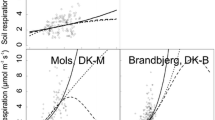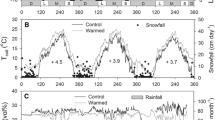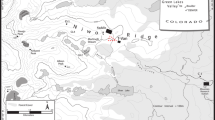Abstract
Understanding the response of soil respiration to climate variability is critical to formulate realistic predictions of future carbon (C) fluxes under different climate change scenarios. There is growing evidence that the influence of long-term climate variability in C fluxes from terrestrial ecosystems is modulated by adjustments in the aboveground–belowground links. Here, we studied the inter-annual variability in soil respiration from a wet shrubland going through successional change in North Wales (UK) during 13 years. We hypothesised that the decline in plant productivity observed over a decade would result in a decrease in the apparent sensitivity of soil respiration to soil temperature, and that rainfall variability would explain a significant fraction of the inter-annual variability in plant productivity, and consequently, in soil respiration, due to excess-water constraining nutrient availability for plants. As hypothesised, there were parallel decreases between plant productivity and annual and summer CO2 emissions over the 13-year period. Soil temperatures did not follow a similar trend, which resulted in a decline in the apparent sensitivity of soil respiration to soil temperature (apparent Q10 values decreased from 9.4 to 2.8). Contrary to our second hypothesis, summer maximum air temperature rather than rainfall was the climate variable with the greatest influence on aboveground biomass and annual cumulative respiration. Since summer air temperature and rainfall were positively associated, the greatest annual respiration values were recorded during years of high rainfall. The results suggest that adjustments in plant productivity might have a critical role in determining the long-term-sensitivity of soil respiration to changing climate conditions.









Similar content being viewed by others
References
Aanderud ZT, Schoolmaster DR Jr, Lennon JT. 2011. Plants mediate the sensitivity of soil respiration to rainfall variability. Ecosystems 14:156–67.
Bader NE, Cheng W. 2007. Rhizosphere priming effect of Populus fremontii obscures the temperature sensitivity of soil organic carbon respiration. Soil Biol Biochem 39:600–6.
Beier C, Emmett B, Gundersen P, Tietema A, Peñuelas J, Estiarte M, Gordon C, Gorissen A, Llorens L, Roda F, Williams D. 2004. Novel approaches to study climate change effects on terrestrial ecosystems in the field: drought and passive nighttime warming. Ecosystems 7:583–97.
Beier C, Emmett BA, Tietema A, Schmidt IK, Peñuelas J, Láng EK, Duce P, De Angelis P, Gorissen A, Estiarte M, de Dato GD, Sowerby A, Kröel-Dulay G, Lellei-Kovács E, Kull O, Mand P, Petersen H, Gjelstrup P, Spano D. 2009. Carbon and nitrogen balances for six shrublands across Europe. Global Biogeochemical Cycles 23.
Bond-Lamberty B, Thomson A. 2010. Temperature-associated increases in the global soil respiration record. Nature 464:579–82.
Ciais P, Reichstein M, Viovy N, Granier A, Ogee J, Allard V, Aubinet M, Buchmann N, Bernhofer C, Carrara A, Chevallier F, De Noblet N, Friend AD, Friedlingstein P, Grunwald T, Heinesch B, Keronen P, Knohl A, Krinner G, Loustau D, Manca G, Matteucci G, Miglietta F, Ourcival JM, Papale D, Pilegaard K, Rambal S, Seufert G, Soussana JF, Sanz MJ, Schulze ED, Vesala T, Valentini R. 2005. Europe-wide reduction in primary productivity caused by the heat and drought in 2003. Nature 437:529–33.
Cranfield University. 2014. The Soils Guide. Available: www.landis.org.uk. Cranfield University, UK. (http://www.landis.org.uk/services/soilsguide/series.cfm?serno=755). Accessed on 18 November 2014.
Curiel-Yuste J, Janssens IA, Carrara A, Ceulemans R. 2004. Annual Q10 of soil respiration reflects plant phenological patterns as well as temperature sensitivity. Glob Change Biol 10:161–9.
Curiel-Yuste J, Ma S, Baldocci DD. 2010. Plant-soil interactions and acclimation to temperature of microbial-mediated soil respiration may affect predictions of soil CO2 efflux. Biogeochemistry 98:38–127.
Davidson EA, Holbrook NM. 2009. Is temporal variation of soil respiration linked to the phenology of photosynthesis? In: Noormets A, Ed. Phenology of ecosystem processes-applications in global change research. New York: Springer. p 187–99.
Davidson EA, Janssens IA. 2006. Temperature sensitivity of soil carbon decomposition and feedbacks to climate change. Nature 440:165–73.
Delpierre N, Soudani K, François C, Le Maire G, Bernhofer C, Kutsch W, Misson L, Rambal S, Vesala T, Dufrêne E. 2012. Quantifying the influence of climate and biological drivers on the interannual variability of carbon exchanges in European forests through process-based modelling. Agric For Meteorol 154–155:99–112.
Domínguez MT, Sowerby A, Smith A, Robinson D, Van Baarsel S, Mills RE, Marshall M, Koller E, Lebron I, Hall J, Emmett B. 2015. Sustained impact of drought on wet shrublands mediated by soil physical changes. Biogeochemistry 122:151–63.
Dijkstra FA, Cheng W. 2007. Interactions between soil and tree roots accelerate long-term soil carbon decomposition. Ecol Lett 10:1046–53.
Emmett BA, Beier C, Estiarte M, Tietema A, Kristensen HL, Williams D, Peñuelas J, Schmidt I, Sowerby A. 2004. The response of soil processes to climate change: results from manipulation studies of shrublands across an environmental gradient. Ecosystems 7:625–37.
Epron D, Nouvellon Y, Roupsard O, Mouvondy W, Mabiala A, Saint-André L, Joffre R, Jourdan C, Bonnefond J-M, Berbigier P, Hamel O. 2004. Spatial and temporal variations of soil respiration in a Eucalyptus plantation in Congo. For Ecol Manag 202:149–60.
Freeman C, Ostle N, Kang H. 2001. An enzymic ‘latch’ on a global carbon store. Nature 409:149.
Fenner N, Freeman C. 2011. Drought-induced carbon loss in peatlands. Nature Geosci 4:895–900.
Fierer N, Colman BP, Schimel JP, Jackson RB. 2006. Predicting the temperature dependence of microbial respiration in soil: A continental-scale analysis. Glob Biogeochem Cycles 20:GB3026.
Fontaine S, Barot S, Barre P, Bdioui N, Mary B, Rumpel C. 2007. Stability of organic carbon in deep soil layers controlled by fresh carbon supply. Nature 450:277–80.
Gimingham CH. 1972. Ecology of heathlands. London: Chapman Hall.
Hall J, Curti C, Dore T, Smith R. 2014. Methods for the calculation of critical loads and their exceedances in the UK, draft report to UK Department of Environment and Rural Affairs-DEFRA. http://nora.nerc.ac.uk/505595/. Accessed 7 September 2015.
Högberg P, Nordgren A, Buchmann N, Taylor AFS, Ekblad A, Högberg MN, Nyberg G, Ottosson-Lofvenius M, Read DJ. 2001. Large-scale forest girdling shows that current photosynthesis drives soil respiration. Nature 411:789–92.
Irvine J, Law BE, Martin JG, Vickers D. 2008. Interannual variation in soil CO2 efflux and the response of root respiration to climate and canopy gas exchange in mature ponderosa pine. Glob Change Biol 14:2848–59.
Ise T, Dunn AL, Wofsy SC, Moorcroft PR. 2008. High sensitivity of peat decomposition to climate change through water-table feedback. Nat Geosci 1:763–6.
Janssens IA, Lankreijer H, Matteucci G, Kowalski AS, Buchmann N, Epron D, Pilegaard K, Kutsch W, Longdoz B, Grünwald T, Montagnani L, Dore S, Rebmann C, Moors EJ, Grelle A, Rannik Ü, Morgenstern K, Oltchev S, Clement R, Guðmundsson J, Minerbi S, Berbigier P, Ibrom A, Moncrieff J, Aubinet M, Bernhofer C, Jensen NO, Vesala T, Granier A, Schulze E-D, Lindroth A, Dolman AJ, Jarvis PG, Ceulemans R, Valentini R. 2001. Productivity overshadows temperature in determining soil and ecosystem respiration across European forests. Glob Change Biol 7:269–78.
Jia X, Zhou X, Luo Y, Xue K, Xue X, Xu X, Yang Y, Wu L, Zhou J. 2014. Effects of substrate addition on soil respiratory carbon release under long-term warming and clipping in a tallgrass prairie. PLoS ONE 9:e114203.
Jing Y, Guan D, Wu J, Wang A, Jin C, Yuan F. 2015. An experimental comparison of two methods on photosynthesis driving soil respiration: girdling and defoliation. PLoS ONE 10:e0132649.
Jones PD, Jonsson T, Wheeler D. 1997. Extension to the North Atlantic oscillation using early instrumental pressure observations from Gibraltar and south-west Iceland. Int J Climatol 17:1433–50.
Kirschbaum MUF. 2004. Soil respiration under prolonged soil warming: are rate reductions caused by acclimation or substrate loss? Glob Change Biol 10:1870–7.
Knohl A, Werner R, Brand W, Buchmann N. 2005. Short-term variations in δ13C of ecosystem respiration reveals link between assimilation and respiration in a deciduous forest. Oecologia 142:70–82.
Knapp A, Carroll CW, Denton E, La Pierre K, Collins S, Smith M. 2015. Differential sensitivity to regional-scale drought in six central US grasslands. Oecologia 177:949–57.
Kopittke GR, van Loon EE, Tietema A, Asscheman D. 2013. Soil respiration on an aging managed heathland: identifying an appropriate empirical model for predictive purposes. Biogeosciences 10:3007–38.
Knorr W, Prentice IC, House JI, Holland EA. 2005. Long-term sensitivity of soil carbon turnover to warming. Nature 433:298–301.
Kuzyakov Y, Gavrichkova O. 2010. Time lag between photosynthesis and carbon dioxide efflux from soil: a review of mechanisms and controls. Glob Change Biol 16:3386–406.
Larsen KS, Ibrom A, Beier C, Jonasson S, Michelsen A. 2007. Ecosystem respiration depends strongly on photosynthesis in a temperate heath. Biogeochemistry 85:201–13.
Liu L, King JS, Booker FL, Giardina CP, Lee Allen H, Hu S. 2009. Enhanced litter input rather than changes in litter chemistry drive soil carbon and nitrogen cycles under elevated CO2: a microcosm study. Glob Change Biol 15:441–53.
Luo Y, Zhou X. 2006. Soil respiration and the environment. Burlington: Academic Press.
Mahecha M, Reichstein M, Carvalhais N, Lasslop G, Lange H, Seneviratne SI, Vargas R, Ammann C, Arain MA, Cescatti A, Janssens IA, Migliavacca M, Montagnani L, Richardson AD. 2010. Global convergence in the temperature sensitivity of respiration at ecosystem level. Science 329:838–40.
Maier CA, Kress LW. 2000. Soil CO2 evolution and root respiration in 11 year-old loblolly pine (Pinus taeda) plantations as affected by moisture and nutrient availability. Can J For Res 30:347–59.
Marcolla B, Cescatti A, Manca G, Zorer R, Cavagna M, Fiora A, Gianelle D, Rodeghiero M, Sottocornola M, Zampedri R. 2011. Climatic controls and ecosystem responses drive the inter-annual variability of the net ecosystem exchange of an alpine meadow. Agric For Meteorol 151:1233–43.
Met Office. 2012. Met Office Integrated Data Archive System (MIDAS) Land and Marine Surface Stations Data (1853-current). NCAS British Atmospheric Data Center.
Migliavacca M, Reichstein M, Richardson AD, Colombo R, Sutton MA, Lasslop G, Tomelleri E, Wohlfahrt G, Carvalhais N, Cescatti A, Mahecha MD, Montagnani L, Papale D, Zaehle S, Arain A, Arneth A, Black TA, Carrara A, Dore S, Gianelle D, Helfter C, Hollinger D, Kutsch WL, Lafleur PM, Nouvellon Y, Rebmann C, Da Rocha HR, Rodeghiero M, Roupsard O, Sebastiá MT, Seufert G, Soussana JF, Van Der Molen MK. 2011. Semiempirical modeling of abiotic and biotic factors controlling ecosystem respiration across eddy covariance sites. Glob Change Biol 17:390–409.
Ottersen G, Planque B, Belgrano A, Post E, Reid PC, Stenseth NC. 2001. Ecological effects of the North Atlantic Oscillation. Oecologia 128:1–14.
Peñuelas J, Prieto P, Beier C, Cesaraccio C, De Angelis P, De Dato G, Emmett BA, Estiarte M, Garadnai J, Gorissen A, Láng EK, Kröel-Dulay G, Llorens L, Pellizzaro G, Riis-Nielsen T, Schmidt IK, Sirca C, Sowerby A, Spano D, Tietema A. 2007. Response of plant species richness and primary productivity in shrublands along a north–south gradient in Europe to seven years of experimental warming and drought: reductions in primary productivity in the heat and drought year of 2003. Glob Change Biol 13:2563–81.
Pietikäinen J, Pettersson M, Bååth E. 2005. Comparison of temperature effects on soil respiration and bacterial and fungal growth rates. FEMS Microbiol Ecol 52:49–58.
Quin SLO, Artz RRE, Coupar AM, Woodin SJ. 2015. Calluna vulgaris-dominated upland heathland sequesters more CO2 annually than grass-dominated upland heathland. Sci Total Environ 505:740–7.
Raich JW, Potter CS, Bhagawati D. 2002. Interannual variability in global soil respiration, 1980–94. Glob Change Biol 8:800–12.
Ratkowsky DA, Olley J, McMeekin TA, Ball A. 1982. Relationship between temperature and growth rate of bacterial cultures. J Bacteriol 149:1–5.
Reichstein M. 2003. Modeling temporal and large-scale spatial variability of soil respiration from soil water availability, temperature and vegetation productivity indices. Glob Biogeochem Cycles 17:1104.
Reynolds B, Chamberlain PM, Poskitt J, Woods C, Scott WA, Rowe EC, Robinson DA, Frogbrook ZL, Keith AM, Henrys PA, Black HIJ, Emmett BA. 2013. Countryside Survey: National “Soil Change” 1978–2007 for Topsoils in Great Britain—acidity, carbon, and total nitrogen status. Vadose Zone J 12.
Richardson AD, Hollinger DY, Aber JD, Ollinger SV, Braswell BH. 2007. Environmental variation is directly responsible for short- but not long-term variation in forest-atmosphere carbon exchange. Glob Change Biol 13:788–803.
Rinnan R, Rousk J, Yergeau E, Kowalchuk GA, Bååth E. 2009. Temperature adaptation of soil bacterial communities along an Antarctic climate gradient: predicting responses to climate warming. Glob Change Biol 15:2615–25.
Rinnan R, Michelsen A, Bååth E. 2011. Long-term warming of a subarctic heath decreases soil bacterial community growth but has no effects on its temperature adaptation. Appl Soil Ecol 47:217–20.
Robinson DA, Jones SB, Lebron I, Reinsch S, Domínguez MT, Smith AR, Jones DL, Marshall MR, Emmett BA. 2016. Experimental evidence for drought induced alternative stable states of soil moisture. Sci Rep 6:20018.
Sampson DA, Janssens IA, Curiel-Yuste J, Ceulemans R. 2007. Basal rates of soil respiration are correlated with photosynthesis in a mixed temperate forest. Glob Change Biol 13:2008–17.
Scott-Denton LE, Sparks KL, Monson RK. 2003. Spatial and temporal controls of soil respiration rate in a high-elevation, subalpine forest. Soil Biol Biochem 35:525–34.
Shao J, Zhou X, He H, Yu G, Wang H, Yi Luo, Chen J, Gu L, Li B. 2014. Partitioning climatic and biotic effects on interannual variability of ecosystem carbon exchange in three ecosystems. Ecosystems 17:1186–201.
Stoy PC, Richardson AD, Baldocchi DD, Katul GG, Stanovick J, Mahecha MD, Reichstein M, Detto M, Law BE, Wohlfahrt G, Arriga N, Campos J, McCaughey JH, Montagnani L, Paw UKT, Sevanto S, Williams M. 2009. Biosphere-atmosphere exchange of CO2 in relation to climate: a cross-biome analysis across multiple time scales. Biogeosciences 6:2297–312.
Sowerby A, Emmett BA, Williams D, Beier C, Evans CD. 2010. The response of dissolved organic carbon (DOC) and the ecosystem carbon balance to experimental drought in a temperate shrubland. Eur J Soil Sci 61:697–709.
Sulzman EW, Brant JB, Bowden RD, Lajtha K. 2005. Contribution of aboveground litter, belowground litter, and rhizosphere respiration to total soil CO2 efflux in an old growth coniferous forest. Biogeochemistry 73:231–56.
Suseela V, Conant RT, Wallenstein MD, Dukes JS. 2012. Effects of soil moisture on the temperature sensitivity of heterotrophic respiration vary seasonally in an old-field climate change experiment. Glob Change Biol 18:336–48.
Tang X-L, Zhou G-Y, Liu S-G, Zhang D-Q, Liu S-Z, Li J, Zhou C-Y. 2006. Dependence of soil Respiration on soil Temperature and soil moisture in successional forests in Southern China. J Integr Plant Biol 48:654–63.
Thiessen S, Gleixner G, Wutzler T, Reichstein M. 2013. Both priming and temperature sensitivity of soil organic matter decomposition depend on microbial biomass—an incubation study. Soil Biol Biochem 57:739–48.
Thomas CK, Law BE, Irvine J, Martin JG, Pettijohn JC, Davis KJ. 2009. Seasonal hydrology explains interannual and seasonal variation in carbon and water exchange in a semiarid mature ponderosa pine forest in central Oregon. J Geophys Res 114.
Trumbore S. 2000. Age of soil organic matter and soil respiration: radiocarbon constraints on belowground C dynamics. Ecol Appl 10:399–411.
Wan S, Luo Y. 2003. Substrate regulation of soil respiration in a tallgrass prairie: results of a clipping and shading experiment. Glob Biogeochem Cycles 17.
Wang X, Piao S, Ciais P, Janssens IA, Reichstein M, Peng S, Wang T. 2010. Are ecological gradients in seasonal Q10 of soil respiration explained by climate or by vegetation seasonality? Soil Biol Biochem 42:1728–34.
Wang Y, Li Q, Wang H, Wen X, Yang F, Ma Z, Liu Y, Sun X, Yu G. 2011. Precipitation frequency controls interannual variation of soil respiration by affecting soil moisture in a subtropical forest plantation. Can J For Res 41:1897–906.
Wei W, Weile C, Shaopeng W. 2010. Forest soil respiration and its heterotrophic and autotrophic components: global patterns and responses to temperature and precipitation. Soil Biol Biochem 42:1236–44.
Yan J, Zhang D, Zhou G, Liu J. 2009. Soil respiration associated with forest succession in subtropical forests in Dinghushan Biosphere Reserve. Soil Biol Biochem 41:991–9.
Zhou T, Shi P, Hui D, Luo Y. 2009. Global pattern of temperature sensitivity of soil heterotrophic respiration (Q10) and its implications for carbon-climate feedback. J Geophys Res 114.
Zhu B, Cheng W. 2011. Rhizosphere priming effect increases the temperature sensitivity of soil organic matter decomposition. Glob Change Biol 17:2172–83.
Zuur A, Ieno EN, Walker N, Saveliev A, Smith GM. 2009. Mixed effects models and extensions in ecology with R. New York: Springer.
Acknowledgements
We thank all the CEH staff members who have contributed to the experiment establishment and maintenance over the years, in particular Alwyn Sowerby and David Williams. This research was funded by the EU projects CLIMOOR, VULCAN and INCREASE FP7-INFRASTRUCTURE-2008-1 (Grant Agreement No. 227628)—the INCREASE project. M.T.D was supported by two postdoctoral fellowships awarded by the Spanish Government (National Science and Technology Foundation and Juan de la Cierva fellowship). We thank two anonymous reviewers for their suggestions on previous versions of the manuscript.
Author information
Authors and Affiliations
Corresponding author
Additional information
Author Contributions
BAE conceived and supervised the experiment. MTD, ARS and SR collected data and contributed to experimental maintenance. MTD led data analysis and wrote the paper. BAE, ARS and SR commented on the manuscript.
Electronic supplementary material
Below is the link to the electronic supplementary material.
Rights and permissions
About this article
Cite this article
Domínguez, M.T., Smith, A.R., Reinsch, S. et al. Inter-annual Variability of Soil Respiration in Wet Shrublands: Do Plants Modulate Its Sensitivity to Climate?. Ecosystems 20, 796–812 (2017). https://doi.org/10.1007/s10021-016-0062-3
Received:
Accepted:
Published:
Issue Date:
DOI: https://doi.org/10.1007/s10021-016-0062-3




